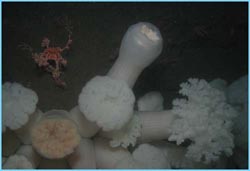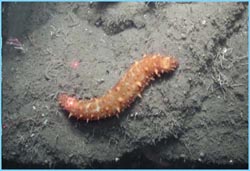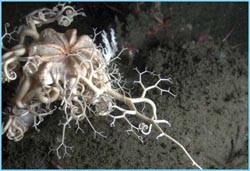Ocean Bottom
 The ocean floor, also called the bottom or benthic area of the Sanctuary, provides a diversity of habitats for both benthic dwelling organisms, as well as those that forage but do not necessary dwell there, such as gray whales. We learn about habitats of the seafloor using several tools including geophysical remote sensing devices, bottom sampling and underwater video. The remote sensing tools use acoustics or sound to produce data that is processed into imagery for interpretation of substrate, depth, and features on the seafloor. flatfishCommon remote sensing tools include side scan sonar and multibeam. Interpretation of remote sensing data is verified using seafloor samples or underwater video. Using this information we classify the habitats of the sanctuary by substrate type, depth, slope, relief and morphology. As we gather information on the composition of benthic communities, we also associate these with the habitat information. Bottom samples and underwater video provide us information on the benthic communities inhabiting the Sanctuary.
The ocean floor, also called the bottom or benthic area of the Sanctuary, provides a diversity of habitats for both benthic dwelling organisms, as well as those that forage but do not necessary dwell there, such as gray whales. We learn about habitats of the seafloor using several tools including geophysical remote sensing devices, bottom sampling and underwater video. The remote sensing tools use acoustics or sound to produce data that is processed into imagery for interpretation of substrate, depth, and features on the seafloor. flatfishCommon remote sensing tools include side scan sonar and multibeam. Interpretation of remote sensing data is verified using seafloor samples or underwater video. Using this information we classify the habitats of the sanctuary by substrate type, depth, slope, relief and morphology. As we gather information on the composition of benthic communities, we also associate these with the habitat information. Bottom samples and underwater video provide us information on the benthic communities inhabiting the Sanctuary.
The seafloor of the Sanctuary encompasses over 3,300 square miles. To date we have mapped only about 20 percent of the seafloor, so we still know relatively little about the habitat and benthic communities in the Sanctuary. Each year we conduct more seafloor mapping and habitat classification, and studies to learn about benthic community composition. In June 2004, aboard the NOAA Ship McArthur II, we used our side scan sonar mapping data to select likely targets for underwater viewing of deep sea corals and sponge, and verification of the side scan data interpretation. Using a remotely operated vehicle (ROV) equipped with a video camera, we were able to video tape the seafloor and benthic communities. We did indeed find both soft and hard corals, as well as several species of sponge!
 Prior to remote sensing, a common tool for seafloor mapping was to take soundings and bottom samples. Maps of the Sanctuary seafloor have been created using these data to provide preliminary information about the seafloor. These methods are antiquated and provide only spot data that must be extrapolated for areas between the samples. sea cucumber From these data, and the remote sensing data we have collected, we have a picture that will be improved upon with detailed knowledge over time. Benthic habitats in the Sanctuary range from sand and mud bottoms, to pebble, cobble and bedrock, from depths extending from the intertidal to 1,477 meters (4,800 feet) in the Quinault Canyon.
Prior to remote sensing, a common tool for seafloor mapping was to take soundings and bottom samples. Maps of the Sanctuary seafloor have been created using these data to provide preliminary information about the seafloor. These methods are antiquated and provide only spot data that must be extrapolated for areas between the samples. sea cucumber From these data, and the remote sensing data we have collected, we have a picture that will be improved upon with detailed knowledge over time. Benthic habitats in the Sanctuary range from sand and mud bottoms, to pebble, cobble and bedrock, from depths extending from the intertidal to 1,477 meters (4,800 feet) in the Quinault Canyon.  Within the Sanctuary boundary are the heads of three submarine canyons, Nitinat, Juan de Fuca and Quinault from north to south, and troughs of the Juan de Fuca Canyon extend throughout the northern portion of the Sanctuary. metridium anemones Sand waves, from less than a meter tall to several meters tall have also been documented. As we gain knowledge about the habitat and the benthic communities, we will be able to study the associations between the two, allowing us to predict communities where we have not yet explored, slowly allowing us to piece together a picture of the ocean floor.
Within the Sanctuary boundary are the heads of three submarine canyons, Nitinat, Juan de Fuca and Quinault from north to south, and troughs of the Juan de Fuca Canyon extend throughout the northern portion of the Sanctuary. metridium anemones Sand waves, from less than a meter tall to several meters tall have also been documented. As we gain knowledge about the habitat and the benthic communities, we will be able to study the associations between the two, allowing us to predict communities where we have not yet explored, slowly allowing us to piece together a picture of the ocean floor.
 Deep Sea Crabs
Deep Sea Crabs